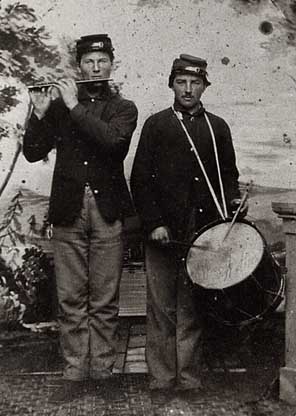Annotation:Kenderbeck's: Difference between revisions
(Created page with "'''Back to [[{{BASEPAGENAME}}]]''' ---- <p><font face="garamond, serif" size="4"> '''KENDERBECK'S'''. American, Quickstep March (2/4 time). D Major. Standard tuning (fiddle). ...") |
m (Text replacement - "garamond, serif" to "sans-serif") |
||
| (2 intermediate revisions by one other user not shown) | |||
| Line 1: | Line 1: | ||
'''Back to [[{{BASEPAGENAME}}]]''' | =='''Back to [[{{BASEPAGENAME}}]]'''== | ||
---- | ---- | ||
<p><font face=" | <p><font face="sans-serif" size="4"> | ||
'''KENDERBECK'S'''. American, Quickstep March (2/4 time). D Major. Standard tuning (fiddle). AABB. In 1862 Bruce and Emmett's '''Drummers' and Fifers' Guide''' was published to help codify and train the hordes of new musicians in Union Army service early in the American Civil War. George Bruce was a drum major in the New York National Guard, 7th Regiment, and had served in the United States Army as principal drum instructor at the installation at Governor's Island in New York harbor. Emmett was none-other than Daniel Decatur Emmett, a principal figure in the mid-19th century minstrel craze and composer of "[[Dixie]]" (ironically turned into a Confederate anthem during the war) and "[[Old Dan Tucker]]," among other favorites. Emmett had been a fifer for the 6th U.S. Infantry in the mid-1850's. | '''KENDERBECK'S'''. American, Quickstep March (2/4 time). D Major. Standard tuning (fiddle). AABB. In 1862 Bruce and Emmett's '''Drummers' and Fifers' Guide''' was published to help codify and train the hordes of new musicians in Union Army service early in the American Civil War. George Bruce was a drum major in the New York National Guard, 7th Regiment, and had served in the United States Army as principal drum instructor at the installation at Governor's Island in New York harbor. Emmett was none-other than Daniel Decatur Emmett, a principal figure in the mid-19th century minstrel craze and composer of "[[Dixie]]" (ironically turned into a Confederate anthem during the war) and "[[Old Dan Tucker]]," among other favorites. Emmett had been a fifer for the 6th U.S. Infantry in the mid-1850's. | ||
[[File:fife.jpg|300px|thumb|left|Union Army musicians]] | |||
<br> | <br> | ||
<br> | <br> | ||
</font></p> | </font></p> | ||
<p><font face=" | <p><font face="sans-serif" size="4"> | ||
''Source for notated version'': | ''Source for notated version'': | ||
<br> | <br> | ||
<br> | <br> | ||
</font></p> | </font></p> | ||
<p><font face=" | <p><font face="sans-serif" size="4"> | ||
''Printed sources'': '''Bruce & Emmett's Drummers' and Fifers' Guide''', 1862; p. 58. | ''Printed sources'': '''Bruce & Emmett's Drummers' and Fifers' Guide''', 1862; p. 58. | ||
<br> | <br> | ||
<br> | <br> | ||
</font></p> | </font></p> | ||
<p><font face=" | <p><font face="sans-serif" size="4"> | ||
''Recorded sources'': <font color=teal></font> | ''Recorded sources'': <font color=teal></font> | ||
</font></p> | </font></p> | ||
| Line 22: | Line 23: | ||
<br> | <br> | ||
---- | ---- | ||
'''Back to [[{{BASEPAGENAME}}]]''' | =='''Back to [[{{BASEPAGENAME}}]]'''== | ||
Latest revision as of 13:47, 6 May 2019
Back to Kenderbeck's
KENDERBECK'S. American, Quickstep March (2/4 time). D Major. Standard tuning (fiddle). AABB. In 1862 Bruce and Emmett's Drummers' and Fifers' Guide was published to help codify and train the hordes of new musicians in Union Army service early in the American Civil War. George Bruce was a drum major in the New York National Guard, 7th Regiment, and had served in the United States Army as principal drum instructor at the installation at Governor's Island in New York harbor. Emmett was none-other than Daniel Decatur Emmett, a principal figure in the mid-19th century minstrel craze and composer of "Dixie" (ironically turned into a Confederate anthem during the war) and "Old Dan Tucker," among other favorites. Emmett had been a fifer for the 6th U.S. Infantry in the mid-1850's.

Source for notated version:
Printed sources: Bruce & Emmett's Drummers' and Fifers' Guide, 1862; p. 58.
Recorded sources:
